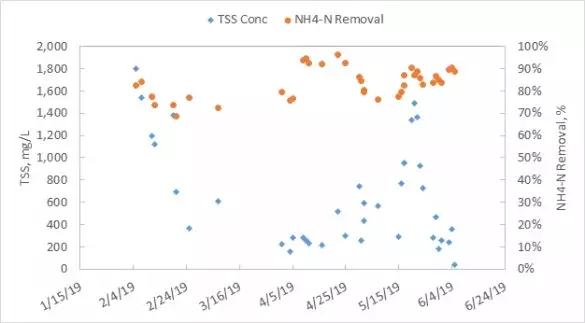The Challenge
In 2013, Howard County began plans for an upgrade to its biosolids management facilities at LPWRP with high rate anaerobic digestion, rebuilt centrifuges for dewatering, a phosphorus recovery system and a sidestream deammonification system. The sidestream process is designed to reduce the impact of nitrogen load returned back to the mainstream treatment process and ensure that the plant meets the stringent discharge TN limit of 3 mg/L. LPWRP required the sidestream process to meet the following:
- Treat centrate with a high solids concentration (800 mg/L or higher) without requiring solids pretreatment.
- Proven, simple and robust treatment process that is supported by successful installations throughout the US.
- Easy to operate and requires minimal maintenance.
- Stable system that retains anammox bacteria easily and is not prone to washout.
- Fit into existing tankage.
The Solution
Howard County and the CMAR team chose Veolia’s ANITA™ Mox MBBR sidestream deammonification process to meet the plant’s requirements while offering project cost savings. ANITA™ Mox utilizes K5 biofilm carriers and media retaining screens, eliminating anammox washout. Biomass (including anammox and AOBs) remains attached to the carriers as high TSS passes through the system.
Process Descrpition
The ANITA™ Mox system was retrofitted into existing tanks with relatively shallow side water depth. The tanks were originally aeration tanks for an industrial waste pretreatment system that was mothballed before the Biosolids Project started. The system components such as the media, media retaining screens and medium bubble aeration diffusers are designed to be maintenance free for the lifetime of the system. The media fill volume of each of the two reactors leaves room for future expansion by simply adding more media if ammonia loading increases. Air for the ANITA™ Mox system is supplied via dedicated blowers as required by the plant. The small footprint of the system is able to save room for two small EQ tanks, designed to provide consistent loading to the reactors for enhanced performance. The patented ANITA™ Mox process controls strategy has the flexibility to be controlled by DO, pH, and/or ammonia for optimal energy savings.
Results
After adding seeded media from an existing BioFarm in the US, the reactors reached the design loading and removal rates despite high influent TSS concentrations. Reactor operation and performance is largely unaffected by high TSS concentrations. Since startup in early 2019, the ANITA™ Mox system continues to meet the design Nitrogen removal rates. The two small ANITA™ Mox reactors are able to remove approximately 15% of the total nitrogen load of the plant with low cost.

The Client
Little Patuxent Water Reclamation Plant (LPWRP) is located in Howard County, Maryland. This is a 29 MGD ENR (Enhanced Nutrient Removal) plant that discharges to the Little Patuxent River which goes to the Chesapeake Bay.


